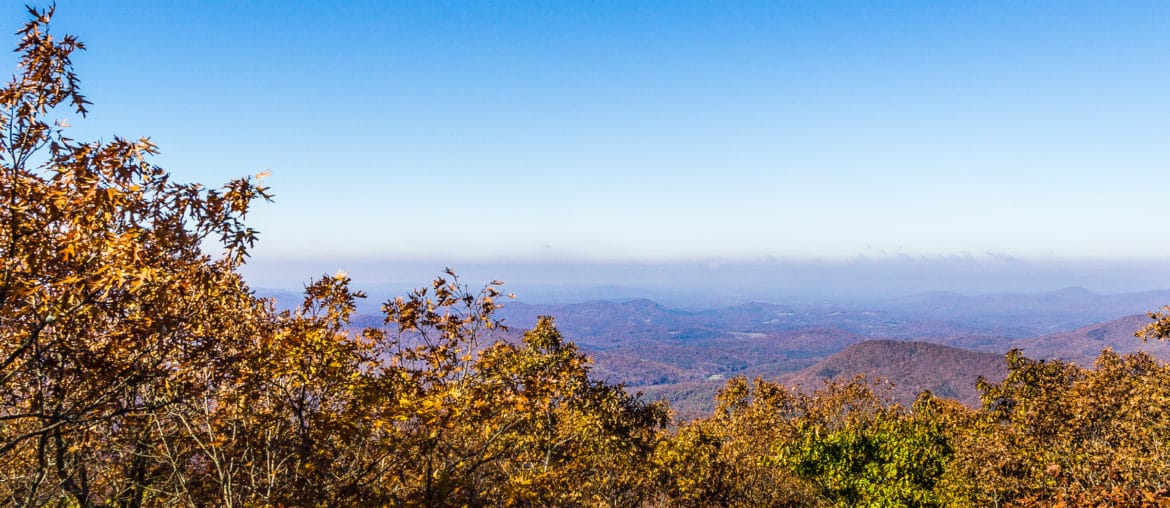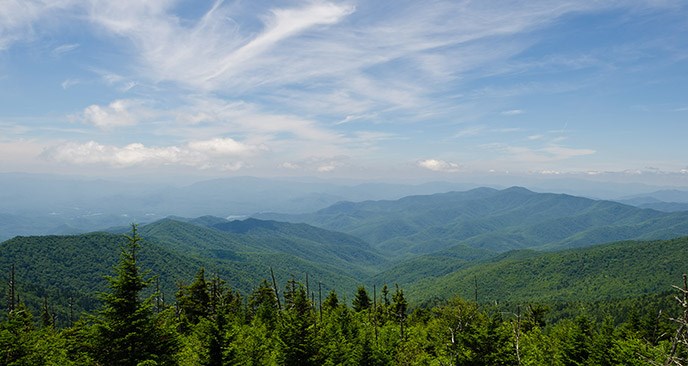Mapping the Appalachian Trail: Landmarks and Milestones
As the longest hiking-only trail in the world, the Appalachian Trail follows along the ridge of the Appalachian Mountains and traverses 2,200 miles, 14 states, and five national parks. Each year thousands of people attempt to hike those 2,200 miles, but only one in four hikers make it all the way from Georgia to Maine. While can take between five to seven months to hike the entirety of the trail, more than two million people each year hike at least some part of the Appalachian Trail. Those two million people sure find hiking the Appalachian Trail enjoyable, and with over 200 landmarks and milestones along the trail, there is little reason to wonder why. There nothing boring about hiking – or mapping – the Appalachian Trail.
View Appalachian Trail Map in a full screen map
Experience the landmarks and milestones of the trail for yourself on the map above, or read on for insights we found here on hiking the Appalachian Trail.
Peaks
You can sort the map by the types of landmarks or milestones you may encounter along the trail. Peaks are hard to miss milestones, and the Appalachian Trail boasts some tall ones. Luckily, or maybe not so much for thru-hikers, the two trailheads at the start and finish of the Appalachian Trail are peaks, and they are pretty tall.
Trailhead: Springer Mountain

Photo Courtesy of Atlanta Trails
At 3,782 feet, Springer Mountain in Georgia is the most popular place to begin the thru-hike on the Appalachian Trail. However, because Springer Mountain is the most popular place to start, it also means that between March 1 and April 15th, the recommended starting season for the hike, the trailhead is usually packed with other hikers also beginning their trek.
Trailhead: Mount Katahdin

Photo Courtesy of Wikipedia
Located at the other end of the Appalachian Trail in Maine is Mount Katahdin. At 5,268 feet, this mountain is even taller than Springer Mountain. The peak marks the end of the Appalachian Trail for most hikers. Fittingly, Mount Katahdin is regarded as the most difficult mountain to hike throughout the Appalachian Trail. Most hikers prefer to save it for last rather than begin the trail here.
Interactive Maps Made Easy
Sign Up NowHighest Peak

Photo Courtesy of Kristina Plaas on National Park Service
The highest peak on the Appalachian Trail is Clingmans Dome. This peak is about 200 miles into the thru-hike starting in Georgia, or about 2,000 miles from the end of the trail in Maine. The peak is located in the Great Smoky Mountains of Tennessee and North Carolina and is 6,643 feet. It is the highest mountain in the Smokies and the highest point in Tennessee. Clingmans Dome is also the third highest point in Eastern North America!
Lowest Peak

Photo Courtesy of the New York State Parks, Recreation & Historic Preservation
On the other hand, the lowest peak on the Appalachian Trail is Bear Mountain Zoo. Closer to the end of the trail in New York, this landmark is only 124 feet above sea level. More than just a zoo, Bear Mountain State Park has many amenities for those hiking the Appalachian Trail or for those just visiting the State Park. Things to do while here include picnicking, fishing, swimming in the swimming pool, visiting the museum or zoo, hiking, biking, cross-country skiing, and ice-skating from late October to mid-March. There is also a Memorial Tower which rests atop Bear Mountain that gives you views of the entire State Park.
Lodging
While many hikers make their way along the Appalachian Trail with only tents to stay in, the trail also has over 35 comfortable lodging accommodations for those who want a more luxurious hiking experience. There are six different types of lodging accommodations along the Appalachian trail: donation-based hostels, churches, shared bathrooms, private rooms, guest houses, and hotels. More than just a place to stay, these lodgings also provide a variety of services that range from shuttles, laundry, kitchen facilities, and showers, to grocery items, supplies, and provided meals.
- Donation-based hostels – Donation-based hostels are just that: donation-based. There are eight of these along the Appalachian Trail, and there is no obligation to pay for your stay, although donations are happily accepted and can be anonymous.
- Churches – There are three hostels housed and operated out of churches along the Appalachian Trail.
- Shared Bathrooms – In the one hostel with shared bathrooms along the trail, you’ll get a room to yourself, but you may run into other hikers in the hall on your way to the shared bathrooms. However, after a solo day of thru-hiking, some small talk in the hall might be just the thing you need.
- Private Rooms – Hostels that have private rooms provide some R&R you may miss out on if you find yourself staying in another type of hostel. They are in no short supply, as there are 20 hostels along the Appalachian Trail that have private rooms.
- Guest Houses – The two guest houses on our list sound pretty accommodating. Sutton’s Place, located in Manchester, Vermont, has been hosted by Frank Sutton for over 30 years. Sutton’s Place actually has 4 guest rooms available in the guest house, ranging from a price of $75-$99. The second guest house option, the North Woodstock Guesthouse, is located in North Woodstock, New Hampshire, and is hosted by Christine for $40 per night.
- Hotels – There are two non-hostel hotels located along the Appalachian Trail if you’re hoping for more of a deluxe accommodation. Both the Fontanna Village Resort and The Doyle Hotel have cozy rooms available for hikers.
Post Offices
Hiking 2,200 miles over the course of 5 to 7 months can be hard, to say the least. While the Appalachian Trail touts hiker hospitality, planning mail drops or bounce boxes may come in handy in case of sickness, really sore feet, or a craving for gummy worms. Whether you pre-send yourself packages filled with essentials before you begin the trail or you’re writing to someone and telling them the next post office destination, the Appalachian Trail is home to over 100 post offices for your use. An important note: the first post office is located 20 miles from the start of the trail, so bring enough essentials to get you through those first 20 miles.
If you’re not ready to hike the trail yet, we understand. You can always make your own trail map today! Also, keep an eye out for our post on hiking highlights of the Pacific Crest Trail, which is 500 miles longer than the Appalachian Trail.
